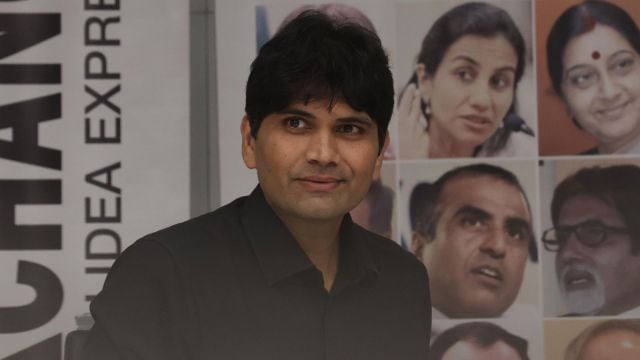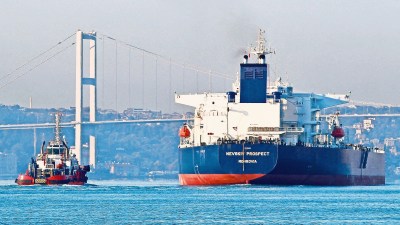BMC additional municipal commissioner-Abhijit Bangar at Express town hall: ‘I expect phase 1 of road concretisation to be completed up to 95% by may 2026’
At a Town Hall event hosted by The Indian Express, Abhijit Bangar, Additional Municipal Commissioner (Projects), Brihanmumbai Municipal Corporation, talks about upcoming civic polls, road concretisation, inter-departmental coordination, and flood mitigation, among other issues.
 In the past, Abhijit Bangar has served as the municipal commissioner at the neighbouring Thane Municipal Corporation (TMC) and Navi Mumbai Municipal Corporation (NMMC). (Express Photo by Amit Chakravarty)
In the past, Abhijit Bangar has served as the municipal commissioner at the neighbouring Thane Municipal Corporation (TMC) and Navi Mumbai Municipal Corporation (NMMC). (Express Photo by Amit Chakravarty)As Mumbai gears up for the Brihanmumbai Municipal Corporation (BMC) elections, The Indian Express speaks to Additional Municipal Commissioner (Projects) Abhijit Bangar about the administrator-run body, large-scale infrastructure projects unfolding the city, and mechanisms to ensure accountability, among other issues pertaining to the maximum city.
In the past, Abhijit Bangar has served as the municipal commissioner at the neighbouring Thane Municipal Corporation (TMC) and Navi Mumbai Municipal Corporation (NMMC).
Q: BMC elections are going to shortly take place. How are you preparing yourself? Once elections conclude, the Opposition will raise multiple issues related to BMC projects that were executed in the last few years?
Abhijit Bangar: As an administrative officer, I can only speak about the preparation for elections. For three years, there has been no mayor, there are no corporators in the BMC, and we are absolutely aware that their absence increases our responsibility. The democratic systems are there for a reason and that raises our accountability. Now that corporators are returning, we need to understand that we are more accountable now.
Before Mumbai, I worked as an administrator in Thane and Navi Mumbai, and I made it a point that my name shouldn’t be named outside the cabin and it should be only mentioned as “commissioner”. I intentionally had made a point that I will never consider that I am working as an administrator. I would hardly take up civic works that were approved by the internal departments, rather I would focus on prioritising works that were recommended by public representatives. Therefore, we need to be more aware about being accountable to people and should remember that the work that we are doing now is going to be audited.
Q: In 2022, then chief minister Eknath Shinde, now a deputy chief minister, had proposed concreting the roads of Mumbai within three years. It has already been three years now, but the overall project is only half way complete and the number of potholes has also risen. So, how do you look at this because a lot of questions are going to be raised on this project, after the body of public representatives is elected?
Abhijit Bangar: Road concretisation was undertaken particularly to combat the growing issue of potholes. The entire work was awarded in two phases. The way I see it now, I expect phase 1, which comprises more than 300 km of roads, to be completed up to 95 per cent by May 2026. In phase II, we are expecting to achieve 85 per cent of progress of work in the next eight months if everything goes well. In the past one year, we received innumerable complaints from citizens since so many roads were dug up at one go. This time, we have learnt our lesson and chalked out alternative methods.
For example, if we have to dig up a road that connects a residential building, then we may be able to provide an alternative access road to the residents of the building. Even if there is no space for concretisation, the road will be taken up for digging in a partial manner to ensure there is adequate space for people to move. In the present cycle, we are also aiming to dig up roads in a phased manner. In the first phase, we will be taking up roads that are partially completed. Only after these roads are completed will the new roads be taken up.
Q: Are you happy with the overall progress of concretising work in terms of both quality and timeline?
Abhijit Bangar: Our implementation has been satisfactory so far. While the question of whether concrete roads are the only way to deal with all the problems of city roads may be debated, we believe that concrete roads definitely have an advantage. There are no potholes on concrete roads and if the implementation is being executed poorly, then there are visible signals. For example, on concrete roads, cracks develop very easily, while in the case of asphalt roads, common people will not be able to point out easily if the implementation has been going bad. Now if you purely look at statistics, the percentage of the roads which have developed cracks is much less than 1 per cent.
We have maintained a slew of checks and balances to ensure the standard of quality is regarded as high. We have roped in quality-monitoring agencies to inspect the finishing standard of work and monitor ongoing work. If, during an inspection, we found that somewhere the quality of the road is not up to the standard, then the first person held accountable is the representative of the agency, whose job is to monitor and maintain the standard of work. We have also appointed IIT Bombay, whose job is to hand hold the contractors in doing the work in the execution phase as well as acting as a third-party monitoring agency, and so far, our experience has been very good with them.
Q: As a bureaucrat heading an agency that has been involved with civic and infrastructure works for so long, has the thought “why don’t we do projects on our own?” ever crossed your or policymakers’ mind? You have the expertise. So what’s stopping you from executing work in entirety instead of giving the contract to private enterprises?
Abhijit Bangar: The scale of projects that we deal with is huge and at that level, doing projects on your own often gets tedious. At the start of my career, especially in the rural area, I had seen various government departments doing projects on their own. I believe that work carried out by government departments on their own is not a guarantee of quality. When it comes to awarding work orders to private contractors, that responsibility for the quality is already fixed on the contractor and if there are any discrepancies, the contractor will be immediately reprimanded. In a mechanism where the contractor system is not working, there is no reason why the departmental system of executing work will work. Rather, I would say the opposite. The maintenance model binds the contractor with a responsibility that no matter how bad the quality of the road gets after you have constructed it, it’s your responsibility to have it fixed.
Q: The issue of desilting the Mithi river is yet to be resolved. Today, there has been an established network between BMC officers, contractors, and politicians, and the economic offences wing (EOW) has filed an FIR against BMC officers as well. When will we see a clean Mithi river and how transparently is the entire desilting drive carried out in Mumbai?
Abhijit Bangar: Cleaning and desilting are very different things. Desilting pertains to removal of silt, which mainly comprises sludge and mud from the bed of the river, to improve flow of water. On the other hand, cleaning of rivers refers to improving overall water quality and the ecosystem. The purpose of desilting is not cleaning but to prevent flooding. As I said, there can be some role in cleaning, but desilting will not clean the water in its entirety. I will not speak on the EOW aspect because the case is ongoing. But there are ways of ensuring transparency in desilting, and technology is the best solution.
This was the first year we used artificial intelligence (AI) to track the progress for desilting. We established our own AI model and trained it to identify debris. Earlier, we used to track the progress of desilting by using photographs, but it was easier for miscreants to manipulate the photographs. Now, we have deployed the AI tool wherein we run videos through our AI tool, which is easily able to identify the silt quantity. It can immediately flag if floating waste or construction debris is being shown as silt just to inflate the numbers. We have mandated the contractors to upload videos of the entire loading process when a truck is loaded with silt. If they don’t upload videos, we don’t pay them. There have been many instances where we caught contractors not following rules while loading the trucks and we straightaway penalised them.
Q: Even though we are working towards making the roads better in Mumbai, the issue of walkability still persists as Mumbai is a very non-pedestrian-friendly city. How are we looking to change this ?
Abhijit Bangar: This walkability issue has been ongoing for several years now. What does walkability actually mean? Firstly, there should be no encroachment on footpaths and secondly, there shouldn’t be any kind of obstruction like parked cars or something. There should be no debris. The basic ground rule is to construct new footpaths as per the specifications mentioned by the Indian Road Congress that would prevent two-wheelers from climbing on footpaths. There needs to be a tactile path on the footpath that would be easy to walk on for all including the disabled. Mumbai has a footpath length of 4,000 km, which is very huge in terms of scale. But we should start somewhere. Therefore, as a first step, in this year’s budget, we have allocated Rs 100 crore as a token provision to address walkability, under which we intend to make Mumbai a pedestrian-friendly city over the next 10-15 years.
Q: As an IAS officer, your basic work is policy formulation and getting policies implemented. A few years ago, the BMC introduced a walkability project by identifying a few sets of roads in South Mumbai and improving their footpaths by spending public money. Soon after, these footpaths were dug up for metro work, which is being executed by an agency other than BMC. Why is this happening? Are the various planning departments that exist in Mumbai not in sync ?
Abhijit Bangar: In many ways, we still are working in silos unfortunately and, I am not talking about this specific issue. I am talking about the overall issues, in general. Whenever I see such a thing happening in my organisation, I am trying to make an effort. At the organisational level, our bosses are trying to make an effort so that all departments and agencies speak or coordinate with each other. For the BMC, we have an internal planning department whose remarks are taken up whenever we carry out any project. But there is a communication gap when there are different agencies involved. This is because there are multiple authorities which are working, which are not talking to each other. And, each authority carries their ego with them.
To some extent, the Government is also taking efforts to bridge this communication gap, for which we are formulating an institutional set up called the Urban Municipal Transport Authority (UMTA). This is being envisaged by the government, for the Mumbai Metropolitan Region (MMR) so that if any transport project (inclusive of roads) is going to come, it would be routed through UMTA. So, that is one place where all these agencies will be present and they are supposed to talk to each other. And, in case there is any overlapping, the agencies/departments involved are supposed to work together in bringing solutions and moving ahead. The reason I see that happening is because I am part of the committee which is drafting UMTA.
Q: Over the past few years, we have seen that 3,000 mm has become the normal for Mumbai during the monsoon season, which is much higher than the average rainfall standards. This has led to extreme flooding and waterlogging in the city, while at the same time, the city’s existing infrastructure to mitigate flooding is pretty old. How are we going forward to making our city more resilient ?
Abhijit Bangar: We are heading into an era where not just rainfall has become erratic, but the frequency of high-intensity rainfall has also increased. And that’s why throughout the year, we have seen more than 100 mm of rainfall several times. For any typical city, the intensity of waterlogging depends on whether the quantity of rainwater will percolate through the surface in which it is falling or whether it will run off. If rainwater falls on the soil, then it will percolate and if that water is falling on a concretised surface, it will run off causing waterlogging.
For a city like Mumbai, its maximum area is developed and already stands concretised, which is why the larger quantum of rainfall water is unable to percolate. At the same time, the intensity of rainfall is increasing, while the rate of percolation is not increasing. So, now we are making a plan of flood mitigation with the help of IIT and with the help of the National Disaster Management Authority (NDMA). We have made a preliminary plan and submitted it, which is expected to go to the Ministry of Home Affairs (MHA), which is going to finance this too.
We have made a comprehensive plan which primarily focuses towards increasing percolation of the ground. There are some solutions like Bioswale or Sponge Park. By and large, you can kind of understand what that particular feature would be doing. With that, the probability of percolation can increase. There are a few measures by which pumping capacity will increase. There are a few measures by which the outfall water due to the Mithi or high tide is not able to go inside. There is a solution to control the tidal effect by installing a gate. We have made that plan.







